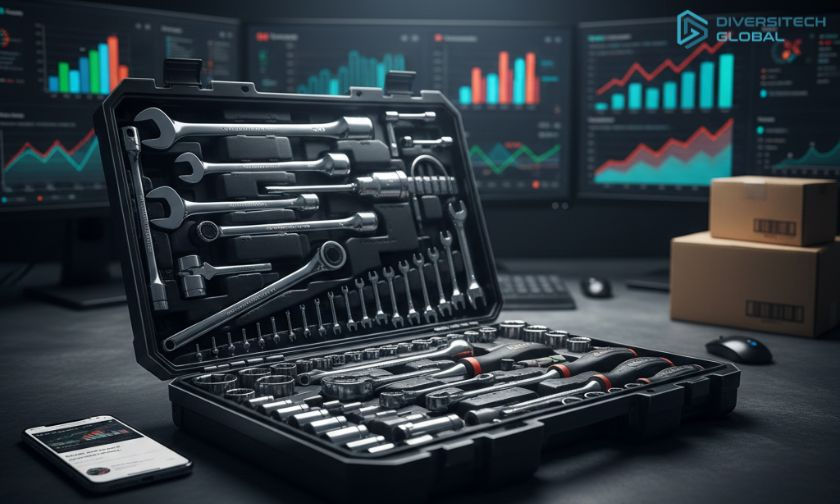From Hammers to Drills: Tracing the Evolution of Hand & Power Tools
- Diversitech Global

- Feb 6, 2024
- 5 min read
Updated: Feb 22, 2024

As the DIY hardware industry continues to evolve, the history of hand and power tools serves as a testament to human innovation and the progress of global manufacturing. From the simplicity of early implements to the cutting-edge precision of modern tools, the evolution of hand and power tools has played a pivotal role in shaping the hardware retail landscape.
This comprehensive exploration aims to unravel the multifaceted narrative of hand and power tools within the context of global manufacturing and hardware shop retails, encompassing historical origins, technological advancements, sustainability considerations, digitalization, and future trends. Business professionals and enthusiasts in the DIY and hardware industry will glean valuable insights from this detailed analysis, shedding light on the pivotal role of tools in driving hardware retail and the nuanced dynamics that have influenced their evolution over time.
Table of Contents:
Historical Origins: Foundations of Hand & Power Tools
The historical origins of hand and power tools are deeply intertwined with the evolution of global manufacturing and the hardware retail sector. This section delves into the foundational roots of hand and power tools, highlighting key milestones that have shaped their trajectory.
Pre-Industrial Era Craftsmanship: The origins of hand tools can be traced back to the pre-industrial era, where skilled craftsmen fashioned rudimentary implements such as hammers, axes, and saws using traditional forging and woodworking techniques. These early tools laid the groundwork for subsequent innovations and reflected the ingenuity of artisans in creating functional implements for various tasks.
Industrial Revolution and Mechanization: The industrial revolution marked a monumental shift in toolmaking, ushering in the mechanization of production processes and the mass manufacturing of standardized tools. This era witnessed the proliferation of hand tools such as chisels, planes, and wrenches, which became essential assets in factories and workshops, driving advancements in global manufacturing capabilities.
Technological Advancements: Precision Engineering and Innovation
Technological advancements have been instrumental in revolutionizing hand and power tools, propelling them from traditional implements to sophisticated precision instruments. This section explores the pivotal role of technological innovations in reshaping the landscape of hand and power tools.
Electrification and Power Tool Revolution: The advent of electrification catalyzed a paradigm shift in the realm of power tools, giving rise to electric drills, sanders, and saws that offered unparalleled speed, torque, and precision. These advanced power tools not only transformed the DIY landscape but also revolutionized manufacturing processes, enhancing efficiency and productivity.
Digitalization and Smart Tools: The integration of digital technology has led to the emergence of smart tools equipped with advanced features such as Bluetooth connectivity, integrated sensors, and app-based controls. Smart power tools, including cordless drills and impact drivers, exemplify the fusion of cutting-edge technology with traditional tool functionality, catering to the evolving needs of DIY enthusiasts and professional users alike.
Global Manufacturing Landscape: Sourcing and Supply Chain Dynamics
The evolution of hand and power tools is intricately linked to the dynamics of global manufacturing, encompassing complex supply chain networks and sourcing strategies. This section sheds light on the impact of global manufacturing on the development and distribution of hand and power tools.
Outsourcing and Offshore Production: The globalization of manufacturing has led to the outsourcing of tool production to countries with cost-effective labor and favorable regulatory environments. This strategic approach has enabled manufacturers to optimize production costs and scale up their operations, thereby influencing the availability and affordability of tools in hardware shop retails worldwide.
Supply Chain Integration and Logistics: The seamless integration of supply chains has facilitated the efficient movement of tools from manufacturing facilities to retail outlets, ensuring a steady and diversified supply of hand and power tools to meet the diverse needs of consumers. Logistics optimization, including just-in-time inventory management and international freight forwarding, has been pivotal in streamlining the global distribution of tools and hardware products.
Sustainability Considerations: Eco-Friendly Materials and Green Practices
In an era characterized by environmental consciousness, the evolution of hand and power tools has been underscored by a growing emphasis on sustainability and eco-friendly practices. This section explores the intersection of sustainability considerations with the manufacturing and retailing of tools.
Recyclable Materials and Green Packaging: Manufacturers have increasingly embraced the use of recyclable materials, such as biodegradable plastics and renewable composites, in the production of tool components and packaging. This shift towards eco-friendly materials reflects a commitment to reducing the environmental footprint of tools and promoting sustainable consumption practices among consumers.
Energy-Efficient Tool Design: The development of energy-efficient power tools, characterized by reduced power consumption and optimized performance, aligns with the industry's drive towards sustainability. Battery-powered tools with long-lasting rechargeable batteries and energy-efficient motors exemplify the industry's effort to minimize energy wastage and promote eco-conscious tool usage.
Want to incorporate sustainability into your craft & art tool kits & double your sales? Get in touch
Digital Transformation: E-Commerce and Online Retail Platforms
The digital transformation has revolutionized the retail landscape, bringing about a dynamic shift in consumer behavior and purchase patterns. This section illuminates the impact of digitalization on the marketing and retailing of hand and power tools, encompassing e-commerce platforms, online marketplaces, and digital marketing strategies.
E-Commerce Penetration and Omnichannel Retailing: The rise of e-commerce has redefined the accessibility of hand and power tools, enabling consumers to browse, compare, and purchase a diverse array of products from the comfort of their homes. Hardware retailers have embraced omnichannel retailing, seamlessly integrating online and offline experiences to provide customers with a cohesive and personalized shopping journey.
Online Marketing Strategies: Digital marketing tactics, including search engine optimization (SEO), social media advertising, and influencer partnerships, have become integral in promoting hand and power tools to a global audience. Interactive product demonstrations, informative blog content, and engaging video tutorials serve as effective strategies for educating and captivating consumers in the digital sphere.
Future Trends: Innovations and Market Dynamics
The trajectory of hand and power tools is poised to witness ongoing advancements and transformative market dynamics. This section delves into the future trends that are set to shape the industry, ranging from technological breakthroughs to shifting consumer preferences.
Industry 4.0 and Automation: The convergence of advanced robotics, artificial intelligence, and automation technologies is expected to revolutionize manufacturing processes, leading to the development of autonomous assembly lines and precision tool manufacturing. Industry 4.0 principles will underpin the next wave of tool innovations, enhancing efficiency, quality control, and customization capabilities.
Sustainable Innovation: The pursuit of sustainable innovation will continue to drive the development of eco-friendly tools, renewable energy-powered devices, and circular economy models that prioritize resource conservation and material recycling. Integrated product life cycle assessments and cradle-to-cradle design principles will guide manufacturers in creating tools with minimal environmental impact.
Navigating the Toolscape of Tomorrow
In an ever-evolving toolscape, the convergence of historical legacies, technological prowess, global manufacturing intricacies, and sustainability imperatives heralds a new era of innovation and opportunity for the hand and power tools industry. As hardware shop retails adapt to the dynamic forces of consumer demand, digitalization, and ecological responsibility, aligning with these transformative trends will be paramount for businesses seeking to thrive in the toolscape of tomorrow.
Related Article: Hand & Power Tools in the Modern Market
Want to incorporate sustainability into your craft & art tool kits & double your sales? Get in touch




Comments